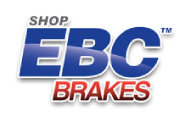Brakes are the most safety critical part of any moving vehicle and in the case of cars and motorcycles quite often when brakes are used repetitively and aggressively, standard is just not good enough. EBC Brakes makes brakes specifically for aggressive drivers. The sport street use or track-day and race use of motor vehicles and motorcycles has led to a need for higher performance brakes such as EBC Sport Rotors and EBC Brakes.
So what does high performance mean and how do we measure this performance ? Brake pads which are made of blends of chemical resins and other ingredients are made to a budget by car builders and are one of the first thing to be changed on a vehicles brakes when users are involved in sport or race use. A high performance brake pad will be one which has good friction level and pedal feel on first application and can hold this level of performance throughout the whole braking cycles. Brakes must not “Fade” or fail under the heat of braking for performance use. Not only must high performance brakes work effectively under heat and load they must have good durability. Additives such as copper are blended into pads used on high performance brake systems to enhance durability.
Brake fluids are also tested in high performance brakes and because most fluids are hygroscopic meaning they absorb moisture, a higher specification fluid is needed and even that will need regular changing and flushing to keep brakes up to par with the target usage.
Finally, the brake rotors themselves must be of a decent quality G3000 Grey iron or better and if possible made from virgin alloy ingot rather than reprocessed irons which are common in 99% of aftermarket brakes. Years ago rotor castings used for automobile brakes were annealed or atmosphere aged to allow the castings to settle after being made. No longer does this happen due to cost restraints on brakes particularly by car builders and so the duty of care falls upon the brake pad to work effectively but not to cause damage to the brake rotor by overheat.
By virtue of the physics involved, brakes work by exchanging kinetic energy or momentum into one of three other energy forms, these being heat light or sound. There are no others. Therefore as it is desirous not to have immense noise from brakes and light would only be obtained by massive over heating of the brake rotor, heat is the method by which the energy exchange in brakes occurs.
This means that brakes can glow orange in high performance use, pads can overheat and fade and rotors could even develop cracks if the brake system is not designed correctly.
In automobile applications cooling of the components within the brakes is usually aided by the ducting of cool air which involves scoops in the front vehicles body work directing cool air as the car is driven onto the brake components. This can reduce overheating of the brakes by 30-40% and prevent caliper seal damage as well as rotor over heat and pad fade.
For help in finding the right High Performance brakes for your vehicle visit www.shopebcbrakes.com










